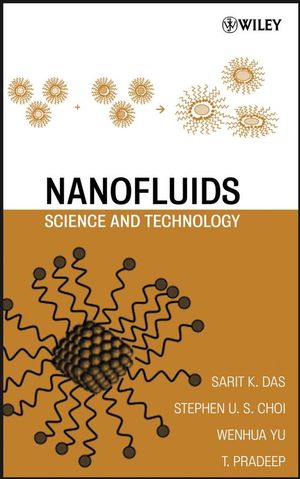Nanofluids: Science and TechnologyISBN: 978-0-470-07473-2
Hardcover
416 pages
December 2007
 This is a Print-on-Demand title. It will be printed specifically to fill your order. Please allow an additional 10-15 days delivery time. The book is not returnable.
|
||||||
Introduction to nanofluids--their properties, synthesis,
characterization, and applications
Nanofluids are attracting a great deal of interest with their enormous potential to provide enhanced performance properties, particularly with respect to heat transfer. In response, this text takes you on a complete journey into the science and technology of nanofluids. The authors cover both the chemical and physical methods for synthesizing nanofluids, explaining the techniques for creating a stable suspension of nanoparticles. You get an overview of the existing models and experimental techniques used in studying nanofluids, alongside discussions of the challenges and problems associated with some of these models.
Next, the authors set forth and explain the heat transfer applications of nanofluids, including microelectronics, fuel cells, and hybrid-powered engines. You also get an introduction to possible future applications in large-scale cooling and biomedicine.
This book is the work of leading pioneers in the field, one of whom holds the first U.S. patent for nanofluids. They have combined their own first-hand knowledge with a thorough review of theliterature. Among the key topics are:
*
Synthesis of nanofluids, including dispersion techniques and characterization methods
*
Thermal conductivity and thermo-physical properties
*
Theoretical models and experimental techniques
*
Heat transfer applications in microelectronics, fuel cells, and vehicle engines
This text is written for researchers in any branch of science and technology, without any prerequisite.It therefore includes some basic information describing conduction, convection, and boiling of nanofluids for those readers who may not have adequate background in these areas. Regardless of your background, you'll learn to develop nanofluids not only as coolants, but also for a host ofnew applications on the horizon.
Nanofluids are attracting a great deal of interest with their enormous potential to provide enhanced performance properties, particularly with respect to heat transfer. In response, this text takes you on a complete journey into the science and technology of nanofluids. The authors cover both the chemical and physical methods for synthesizing nanofluids, explaining the techniques for creating a stable suspension of nanoparticles. You get an overview of the existing models and experimental techniques used in studying nanofluids, alongside discussions of the challenges and problems associated with some of these models.
Next, the authors set forth and explain the heat transfer applications of nanofluids, including microelectronics, fuel cells, and hybrid-powered engines. You also get an introduction to possible future applications in large-scale cooling and biomedicine.
This book is the work of leading pioneers in the field, one of whom holds the first U.S. patent for nanofluids. They have combined their own first-hand knowledge with a thorough review of theliterature. Among the key topics are:
*
Synthesis of nanofluids, including dispersion techniques and characterization methods
*
Thermal conductivity and thermo-physical properties
*
Theoretical models and experimental techniques
*
Heat transfer applications in microelectronics, fuel cells, and vehicle engines
This text is written for researchers in any branch of science and technology, without any prerequisite.It therefore includes some basic information describing conduction, convection, and boiling of nanofluids for those readers who may not have adequate background in these areas. Regardless of your background, you'll learn to develop nanofluids not only as coolants, but also for a host ofnew applications on the horizon.



